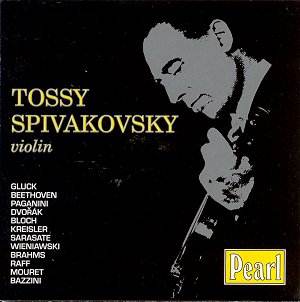Collectors of early LPs may well remember the name
Tossy Spivakovsky. His lithe recordings of the Tchaikovsky and Sibelius
concertos, amongst others, were popular in their time but he never achieved
a real level of sustained international success and his career rather
trailed off. Born in Odessa in 1907 he had a solid foundation studying
in Berlin with the outstanding Italian violinist Arrigo Serato and later
with Willy Hess at the Hochschule. In 1926 he was talent spotted by
Furtwängler and became one of the leaders of the Berlin Philharmonic
until, a year later, he left to follow an incipient solo career soon
to founder with the arrival of the Nazis. He taught for a number of
years in Australia before leaving for America where he led the Cleveland
Orchestra and, rather sensationally, he gave the first performance in
America of the Second Bartók Concerto under Rodzinski, and then
repeated it in New York (a performance of which Bartók heard
–"soloist first rate"). With that his prestige rose, his engagements
increased and his solo profile remained high.
Spivakovsky was famous for his violinistic idiosyncrasies
– he famously held the bow above the frog and the violin was held very
flat with the result that the fiddle was way out over to the left, as
noted by violist Emmanuel Vardi and quoted in Tully Potter’s notes.
As we can hear in these Berlin Parlophones dating between 1924 and 1931
Spivakovsky had an exceptionally fast vibrato and his bowing peculiarities
meant that he possessed less tonal colourisation than was perhaps optimum.
Nevertheless there is an absolute core to his tone and his vibrato whilst
usually of considerable velocity is not oscillatory. He is capable of
frequently expressive playing with a highly personalised temperament
if sometimes falling a little short in matters of nuance.
In the Bazzini the left hand pizzicatos are tossed
off with panache, there is cleanliness in all positions and we can appreciate
his narrow bore vibrato with no unnecessary and disruptive rubati. The
Mouret has some fervent and rapt playing whilst in Raff’s ubiquitous
Cavatina, a late acoustic from 1924, he is uncompromisingly slow
with an appropriately slow slide – a young man’s performance. On the
other side of the Raff was the Gluck in which the pianist – conjecturally
held to be Spivakovsky’s talented pianist brother Jascha – sounds unduly
rushed and the pair are guilty of some phrasal over eagerness. Again
this is a rather gauche performance with insufficient space for repose,
salon style downward portamenti and rather unsubtle over inflated rhetoric.
These earlier recordings are instructive in showing us how quickly Spivakovsky
matured from the adolescent talent to the more polished artist he was
to become by 1928. His Bloch is fervid and Kreisler’s Sicilienne
and Rigaudon attractive without quite the last ounce of charm -
it’s certainly fast and with skipping momentum in the Rigaudon.
He is undaunted by the pizzicato passages in Paganini’s 11th
Sonata (in the customary piano arrangement) and he is driving and
triumphant, dissipating technical difficulties in the 12th
Sonata. His Dvorak Slavonic Dance is perhaps a little over
emphatic whereas his Brahms Dance is fervidly done at a moderate
tempo and much more convincing. The Hochstein arrangement of the Brahms
Waltz is elegant, not over-emoted and attractive. His playing
of Kreisler’s delicious Tambourin chinois seems to me to be somewhat
emphatic once again but without any obvious heaviness; it’s very clean,
scrupulous playing but not necessarily especially idiomatic. His performance
of Caprice Viennois is spick and span, articulate in passagework
if sounding a little artificial, a little practised. There’s a rough
start to Wieniawski’s Scherzo-tarantelle – generally though the
copies are excellent with the exception of the murky sounding Turkish
March – but it features some nicely lyric phrasing but not as combustible
as it should be and with a couple of excessive slides. Sarasate’s Introduction
and Tarantelle though receives a real daredevil reading but one
perhaps with moments of worry in the lower strings and emerging – a
personal view, this – as surprisingly uncultured playing. The Danza
Española is a good deal more convincing, rhythmically energetic
without ever losing control and with excellent phrasing.
Very few of Spivakovsky’s Parlophones have been reissued
and they have been done so here with excellent results. It’s a pity
about the booklet cover picture which looks like a fifth generation
copy of an already murky original** but the records themselves
are well transferred with minimal surface noise. Notes by Tully Potter
are biographical and comprehensive. This is altogether a fine conspectus
of a remarkable young talent.
Jonathan Woolf
** a note from pavilion records
Many thanks for your kind review of our Spivakovsky
release but, on a minor matter, I would just like to point out that
the cover is not a "fifth generation copy of an already murky original"
but is in fact a deliberate high key bleachout of an original photograph
to clarify and dramatize. You may not like it, but that is another matter!


